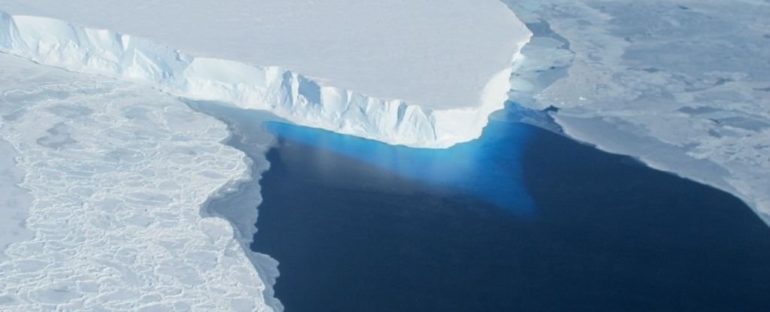A confluence of warm water is threatening to topple the very pillars that keep the ‘Doomsday Glacier’ afloat.
The first measurements ever performed below the icy tongue of Antarctica’s Thwaites Glacier have now revealed a previously underestimated flow of warm water from the east.
This inflow of heat is mixing with other waters below the glacier and encroaching on several critical ‘pinning points’, researchers say, whittling them down from all sides.
If the activity continues or, worse, speeds up, the team is worried it could ultimately detach mass amounts of land-borne ice flowing into Pine Island Bay from the seabed below.
The Thwaites Glacier has been nicknamed the Doomsday Glacier because it is so very large – at 192,000 square kilometers (74,000 square miles), it’s slightly smaller than the state of Kansas in the US – and is melting at an unnerving rate. As a result, the future of the West Antarctic Ice Sheet remains the single largest point of uncertainty for sea-level rise.
Because of the glacier’s remote location and the perilous conditions of the region, only a few measurements have been taken near the edge of the ice shelf, and until now, none had been taken in the cavity below.
“The good news is that we are now, for the first time, collecting data that is necessary to model the dynamics of Thwaite’s glacier,” says physical oceanographer Anna Wåhlin from the University of Gothenburg in Sweden.
“This data will help us better calculate ice melting in the future. With the help of new technology, we can improve the models and reduce the great uncertainty that now prevails around global sea level variations.”
The information was collected by a submersible vehicle named Ran, which swam deep under the thick ice to measure the strength, temperature, salinity, and oxygen content of the underlying ocean currents.
The trip was more successful than scientists had hoped, but the results were not so promising.
Right now, the Thwaites Glacier makes up about 10 percent of the current sea-level rise, but because warm and salty waters tend to converge underneath it, the ice shelf holds the potential to contribute much, much more as the planet warms. Like removing a cork from a wine bottle, the loss of this ice shelf could cause even more ice on the land to melt and flow into the ocean.
In the end, three inflows of warm water were identified by researchers, one of which we had been seriously underestimating. Deepwater flows from the east were thought to be blocked by an underwater ridge nearby, but the new data from Ran suggests these deep currents are still finding their way into the bay.
“The channels for warm water to access and attack Thwaites weren’t known to us before the research,” says geological oceanographer Alastair Graham from the University of Southern Florida.
“Using sonars on the ship, nested with very high-resolution ocean mapping from Ran, we were able to find that there are distinct paths that water takes in and out of the ice shelf cavity, influenced by the geometry of the ocean floor.”
Ultimately, this means warm, salty waters are entering the cavity beneath the Thwaites Ice Shelf from both sides of its main pinning point in the north, possibly destabilizing the entire structure.
It’s still unclear how much of that available heat actually contributes to melting this main pinning point, but the authors predict the energy transported by just one local current is sufficient to melt the above ice at a rate of more than 86,000 kilograms (roughly 95 tons) per year.
That’s equivalent to the total basal melt of the entire Thwaites Ice Shelf between 2010 and 2018, which indicates these warm inflows are likely impacting the entire system’s melting pattern.
“This pinning point is one of the last buttressing features restraining the flow of ice from upstream, and satellite observations indicate that its extent has decreased over the past decades,” the authors write.
The world’s day of doom might arrive sooner than we thought.
The study was published in Science Advances.


